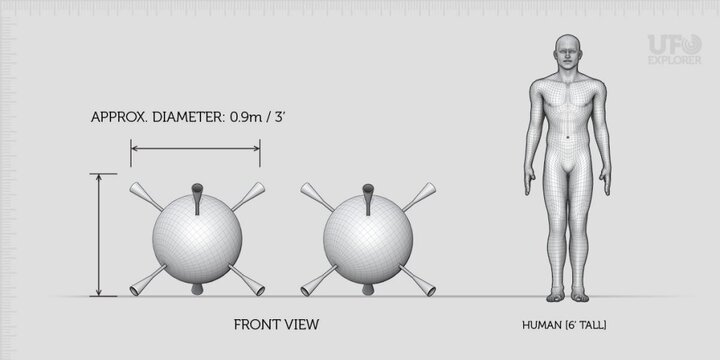We’ve been hearing a lot of talking points from the Reframing the Debate folks in recent months, and this week’s Paracast was no exception.
Susan Demeter-St-Clair is an engaging and charismatic speaker, but in my estimation her logic kept going off the rails when she presented many of the arguments against the ETH that we’ve heard so much about lately. I also found this interview to be oddly frustrating: she’s seen three different and very evidently physical craft, and yet she’s changed her mind and now she seriously questions if they were actually physical craft. But her reasons for doing so make no sense to me.
Here are the key objections to the ETH offered by the advocates of "reframing the debate," and why I think that each one is illogical and/or mistaken:
- The ETH hasn’t solved the ufo enigma in 70 years, so it’s a fruitless direction for progress. Therefore what we need are new ideas.
The first statement is a fundamental error in logic, because a correct hypothesis doesn’t prove itself. What we need is good data, not new ideas (new ideas are always fun to talk about, but ideas don’t answer questions, data answers questions). Progress in understanding any observed phenomenon requires focused scientific efforts such as designing and deploying technical apparatus, collecting data, analyzing the data, and publishing peer-reviewed academic papers about the findings. None of that has been done on the ufo subject, at least not in the public sector. That’s why we haven’t made any progress in understanding the phenomenon. To make real progress we’d need a wide range of technological resources, both dedicated and passive. We’d need things like; quick-response high-speed jets armed with gun cameras and other scientific equipment to gather data from anomalous targets, a professional team of trained scientists to analyze the data collected, a network of cinetheodolites at ufo hotspots and nuclear facilities to film and track anomalous phenomena, and ideally a national passive radar system to track and profile anomalous intrusions of our airspace – which would also be the ideal starting point for the deployment of other observational technology, such as Chris O’Brien’s portable sensor arrays, to event areas. In practice, our military already has all of these kinds of resources so the smartest route would entail enlisting their cooperation for mounting an earnest scientific investigation, but I don’t see that happening without a congressional order.
- Ufos are observed near the Earth but not in space, so they must be local rather than interstellar in origin.
Astronomers have very limited capability with detecting relatively small objects in space, and the public has no access to the AN/FPS-133 Air Force Space Surveillance System’s raw radar data that tracked objects in the near-Earth vicinity for over 50 years. Fairly large meteors arrive without warning all the time - we don’t know about them until they burn up dramatically in the atmosphere. And those move at relatively slow velocities. Fast and rapidly accelerating objects roughly the size of a school bus would be virtually impossible to detect without access to military radar hardware and/or a large network of sensitive dedicated telescopes to observe the celestial sphere, neither of which are available to us.
- There’s no proof of life outside of the solar system.
We don’t have the capability to detect life on exosolar planets, so the absence of such evidence is totally meaningless. However, the data that we can collect right now has proven that roughly 22% of all the stars in the universe are orbited by an Earth-like planet in the habitable zone, and the building blocks of life such as amino acids and other organic molecules permeate space. So we have every reason to expect life to be common throughout the universe. Similarly, SETI’s failure to detect radio signals from other worlds is not at all surprising: if there were an identical SETI program on a planet around the nearest star system, Alpha Centauri, it wouldn’t be sensitive enough to detect any Earth-based radio communications because our transmission signals are too weak. It could pick up some of our high-powered radar transmissions, but even those are too weak to detect at distances much beyond that, and they contain no information. Also, our “radio broadcast era” is already fading away as more efficient targeted satellite relay systems and cable lines now dominate our communications, so if other civilizations have a similarly brief single century of widespread radio transmissions, the odds of a nearby planet going through the same radio era while we happen to be looking for it, is essentially nil.
- If a civilization hundreds or thousands of years more advanced than we are were to visit us, then we wouldn’t even be able to recognize their devices as interstellar craft because they’d be so confounding to us.
This is a bizarre objection – our ability to perceive does not depend on our ability to understand. People accurately described ball lighting, a phenomenon beyond our understanding until very recently, quite accurately. And the indigenous people of the Americas observed Western sailing ships arriving from Europe, and those ships were hundreds if not thousands of years ahead of their technology, yet they reported what they observed accurately. Similarly, if a technological device arrives from another star, we may not understand how it works, but we’d be perfectly capable of describing its appearance and its behavior – even if both of those were highly exotic. Which appears to be exactly what’s happened for at least several decades – people describing strange devices that maneuver with capabilities far beyond our own.
- People reported seeing chariots of the gods and fairies and dragons hundreds of years ago, so we should take that literally, and conclude that the same phenomena that we’re witnessing today has simply changed appearance to suit our expectations.
This is a hollow argument – we didn’t even have the notion of a “flying machine” until roughly a hundred years ago, so nobody would’ve had the language to describe such a thing in the sky. They would’ve had to use terms like “a chariot of the gods” or “an angel glowing in the sky” or “a fiery dragon” to describe something like a ufo. So to impose –our current conception- of those notions, on what they meant when they said “dragon” or “angel” or “chariot”…and conclude that that’s what they were seeing, is a wild and bizarre leap to make. But to take the next step and conclude that, therefore, the same phenomenon that appeared as a winged dragon 500 years ago, appears to us now as a shiny metallic disc or a black triangle with bright lights on each corner, is nuts. There isn’t any indication from psychological or anthropological studies that the human mind is so weak and malleable that a primitive witness would actually observe a mythical creature when confronted with advanced technology. Their terminology is limited to the words that they have in their vocabulary – an ancient Mayan isn’t going have the words to report “I saw a reflective metallic disc-like flying apparatus of possibly extraterrestrial origin that levitated and then accelerated to a velocity of Mach 5 at roughly 100 g’s” – he’s probably going to say something like “My brother – I have seen a vision of Quetzalcoatl this day: we must burn our crops before he punishes us for planting early this growing season.”
- Flaps seem to correspond to sociopolitical upheavals and general societal anxiety, such as the fall of the Berlin wall and McCarthyism.
When has there ever been a quiet time in world history for us to compare this with? Never. The world is always in flux, so this view appears to be nothing more than confirmation bias at work.
- People are changed by their sighting experience, so we should study the witness instead of what has been witnessed.
Of course people are changed by a sighting – any experience that dramatically challenges one’s worldview will have that effect. If our ancient Mayan had seen a nuclear submarine rise to the ocean surface, we wouldn’t learn much about the submarine by studying his/her transformation from a farmer into an artist.
- In abduction reports, the medical procedures seem primitive – they should be able to get what they need non-invasively.
It’s difficult to imagine a time when biopsy procedures will be obsolete – if you want to study what’s going on inside the body, taking a sample is far more informative than an MRI. And a DNA sample like those that we get with a cheek swab, only reveals the DNA blueprint of the organism, not its current biological condition.
- Aliens appear in rooms and walk through walls, which is paranormal/ghost-like behavior.
Almost all of the volume within a solid object is space, so there are probably technological methods for passing material objects through a wall or window; we just haven’t figured out how to do it yet. One could reasonably argue that the ETH predicts that if an alien civilization visits the Earth, then they’d probably have other technological capabilities beyond our own in addition to rapid interstellar spaceflight capability.
- Sightings could involve dream logic and symbology that we’re missing by focusing on the idea of a physical spaceship.
That’s fine, somebody should do a study about that and let us know if they find anything interesting. But personally, I think this is like a blind man looking in a dark room for a black cat which is not there, because these things don’t appear to us as dreamy visions – they appear to us as solid technological craft.
- The idea that ufos are solid craft of some kind is just an untested hypotheses that can’t be verified without examining one in a laboratory setting, and that approach is inherently ill-suited for this investigation anyway because science is rational and the ufo phenomenon is irrational.
Okay first off, we have radar returns and landing impressions: that’s not an untested hypothesis, that’s physical evidence which directly supports the “physical craft” interpretation. They also emit light, and we know from the conservation of energy that light is energy and so it has to be emitted from something physical, like a craft. Also, it’s silly to say that we can’t verify a hypothesis without examining a phenomenon in the lab; we do it all the time. We’ve explained lots of phenomena without isolating them in the lab; the Sun, supernovas, black holes, comets, quasars, the aurora borealis – the list goes on and on. What’s required is precision technical data using scientific instruments to record and measure a phenomenon so that data can then be analyzed, and ultimately yield a physical phenomenological explanation. And finally, no observed phenomenon in the universe is intrinsically irrational, so this suggestion that the scientific method itself is inadequate for understanding ufos is rather alarming. Opponents of the ETH are seriously suggesting that we abandon science and the Age of Reason, in favor of returning to folklore and mythology studies for the answers. That’s kind of terrifying – I don’t want to go back to Dark Ages methodology.
Look – I’m totally open to discussing alternative explanations, but I demand that any proposed explanation holds up to reason. An explanation has to make sense. If it doesn’t, then it’s not a valid explanation, imo. And so far the only hypothesis that’s A.) intelligible and B.) conforms to the vast and growing body of scientific knowledge, is the ETH. All of the other explanations I’ve heard so far simply invoke paranormal/psychic phenomena – but we don’t have explanations for those yet either, so trying to explain one mystery by invoking another mystery does not strike me as a step in the right direction.







